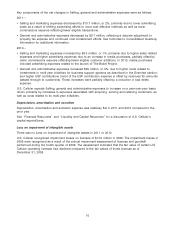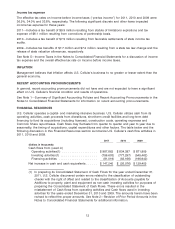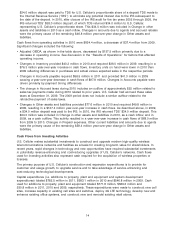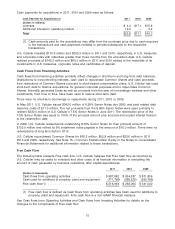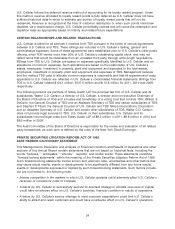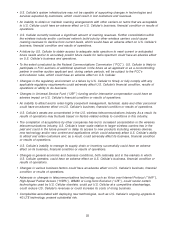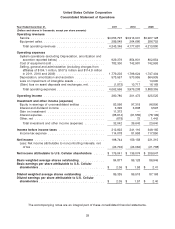US Cellular 2011 Annual Report Download - page 28
Download and view the complete annual report
Please find page 28 of the 2011 US Cellular annual report below. You can navigate through the pages in the report by either clicking on the pages listed below, or by using the keyword search tool below to find specific information within the annual report.
Goodwill
U.S. Cellular tests goodwill for impairment at the level of reporting referred to as a ‘‘reporting unit.’’ For
purposes of impairment testing of goodwill in 2011, U.S. Cellular identified five reporting units based on
geographic service areas. There were no changes to U.S. Cellular’s reporting units, the allocation of
goodwill to those reporting units, or to U.S. Cellular’s overall goodwill impairment testing methodology
between November 1, 2011 and 2010.
A discounted cash flow approach was used to value each reporting unit, using value drivers and risks
specific to the current industry and economic markets. The cash flow estimates incorporated
assumptions that market participants would use in their estimates of fair value and may not be indicative
of U.S. Cellular specific assumptions. The most significant assumptions made in this process were the
revenue growth rate, discount rate, and projected capital expenditures. These assumptions were as
follows for November 1, 2011 and 2010:
November 1, November 1,
Key assumptions 2011 2010
Weighted-average expected revenue growth rate (next four
years) ...................................... 3.58% 2.18%
Weighted-average long-term and terminal revenue growth
rate (after year four) ............................ 2.00% 2.00%
Discount rate ................................... 10.5% 10.5%
Average annual capital expenditures (millions) ........... $609 $540
The increase in the Weighted-average expected revenue growth rate (next four years) between
November 1, 2011 and 2010 was due to improved forecasts for market participants.
The carrying value of each U.S. Cellular reporting unit as of November 1, 2011 was as follows:
Reporting unit Carrying value
(Dollars in millions)
Central Region .......................................... $ 741
Mid-Atlantic Region ....................................... 778
New England Region ...................................... 248
Northwest Region ........................................ 328
New York Region ........................................ 153
Total ................................................. $2,248
As of November 1, 2011, the fair values of the reporting units exceeded their respective carrying values
by amounts ranging from 33% to 106% of the respective carrying values. Therefore, no impairment of
goodwill existed. Given that the fair values of the respective reporting units exceed their respective
carrying values, provided all other assumptions remained the same, the discount rate would have to
increase to a range of 13.0% to 15.7% to yield estimated fair values of reporting units that equal their
respective carrying values at November 1, 2011. Further, assuming all other assumptions remained the
same, the terminal growth rate assumptions would need to decrease to negative amounts, ranging from
negative 24.2% to negative 5.0%, to yield estimates of fair value equal to the carrying values of the
respective reporting units at November 1, 2011.
Licenses
U.S. Cellular tests licenses for impairment at the level of reporting referred to as a ‘‘unit of accounting.’’
For purposes of its impairment testing of licenses as of November 1, 2011, U.S. Cellular separated its
FCC licenses into twelve units of accounting based on geographic service areas. Seven of these twelve
units of accounting represented geographic groupings of licenses which, because they were not being
utilized and, therefore, were not expected to generate cash flows from operating activities in the
foreseeable future, were considered separate units of accounting for purposes of impairment testing. As
of November 1, 2010, U.S. Cellular separated its FCC licenses into eighteen units of accounting based
on geographic service areas. Thirteen of these eighteen units of accounting represented geographic
20


